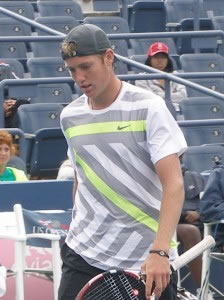
On Sunday he won the U.S. Open Junior Boys singles title with a 3-6, 6-3, 6-2 victory over fellow American Denis Kudla.
But despite that impressive pedigree, the 17-year-old Sock said he doesn’t feel any pressure to be the next great American tennis star.
“I don’t really feel much pressure,” Sock, who lives in Overland Park, Kansas and trains in Kansas City, said Sunday after his victory. “Hopefully we can get to that level one day and be in the American tennis spotlight.
“But we’re just taking it day by day and tournament by tournament and doing what we can. Hopefully we can get to that level some day.”
In 2000, Roddick downed Robby Ginepri for the junior boys title at the Open, the last time two Americans closed out the final. By 2003, Roddick was winning the U.S. Open and had moved to No. 1 in the world. Ginepri made the Open semifinals in 2005 and peaked at No. 15 in the world.
“You know, it would be great if we both made it,” Kudla said of himself and Sock. “If you go by that kind of result, looks like his career is gonna be pretty good.”
Sock, who hit with both Federer and Djokovic during the Open, said he has also received some helpful advice from Roddick, who was also born in Lincoln, Neb., and is the last American man to win a Grand Slam event.
“He said, ‘You can’t get back yesterday,'” Sock said. “If you practice as hard as you can every day, you’ll be happy with the outcome. It’s better not to learn the lesson later in life and to do it earlier and just start working as hard as you can now and not regret your past.”
Sock entered the main draw at the Open, losing in the first round in four sets to Marco Chiudinelli, Federer’s Swiss countryman.
“These guys get into the draw automatically for a reason,” Sock said. “He’s a veteran, and he’s just a little bit more physical than I am and knows a little bit more about really what he’s doing, I guess.”
While Kudla played his last amateur event in Flushing Meadows and will turn professional, Sock is weighing whether to turn pro or attend college. He said he is considering about a dozen schools, including Nebraska, Texas, Texas A&M, Oklahoma, Tennessee and Florida.
“I think the decision about college or pros will be just real simple,” said Mike Wolf, Sock’s coach. “It will just come down to level of play. If he keeps getting better, that’s what will dictate it. I think this [winning the Open] is a step toward probably the picture become more clear, but certainly not the end result. He needs to keep going if he’s gonna go straight to the pros.”
Said Sock: “I think my ultimate goal obviously in tennis is to be a professional tennis player and hopefully make a living, so I’ll just decide which path is the best for me to get there. If it’s college, then it’s college; if it’s pros right away, then it will be pros.”
According to The New York Times, French racket maker Babolat recently examined the top 100 players from the International Tennis Federation’s boys and girls junior rankings over a span of several years.
It then tracked those players who tried to reach the top 100 on the ATP and WTA tours. The results showed that about 7 percent of the world’s top juniors successfully made the transition to a top 100 men’s or women’s player. Barely 1 percent reached the top 10.
Whereas teenagers like Tracy Austin, Jennifer Capriati and Boris Becker once ruled tennis, there is not a single teenager currently ranked in the Top 100 on the ATP Tour.
Patrick McEnroe, the general manager for the United State Tennis Association’s player development program, has been critical of how the search for teenage phenoms has hurt American tennis.
“The bottom line is, we lost a generation of players the last 10 years that should have gone to college but didn’t,” he said.
More recently, players like American John Isner, the Marathon Man who won a 70-68 set at Wimbledon, have made it more acceptable to play college tennis. He competed at Georgia from 2004-7 and has ascended into the Top 20 in the world.
Wolf, Sock’s coach, said Isner’s experience has made college a more acceptable option than it was a few years ago.
“I think so,” he said. “And I think that they’re talking about the average age of the Top 100 player in the world being in the early- to mid-20s now, and that they don’t break into it until at least 23 or 24.
“So I think everybody’s gotta be careful if they’re going to do that [turn pro]. They really have to be ready to be committed and be prepared to compete at that level.”
(Photo courtesy tennis-prose.com)
Follow Adam Zagoria on Twitter



christgs / September 13, 2010
“I don’t really feel much pressure,” Sock, who lives in Lincoln, Neb. and trains in Kansas City, said Sunday after his victory. “Hopefully we can get to that level one day and be in the American tennis spotlight.
—————-
Hey Adam-
Big fan of yours, I wanted to let you know that this information about Jack is incorrect. He actually lives in Overland Park, KS (a suburb of Kansas City).
He grew up in Nebraska, but moved here years ago.
Living as the same area as this kid, I keep up with him, and he’s definitely one of the best future US tennis players around.
Keep up the great work!
/